Where Could Life Exist?

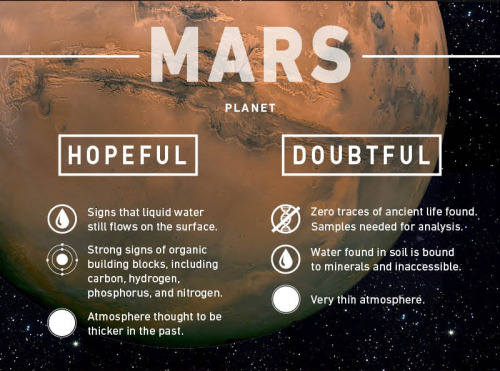
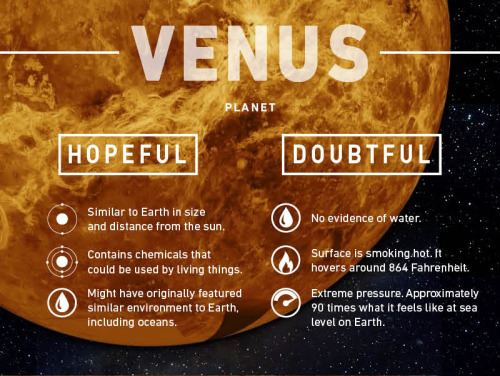
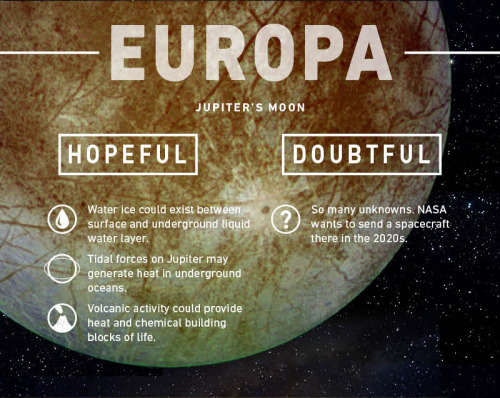
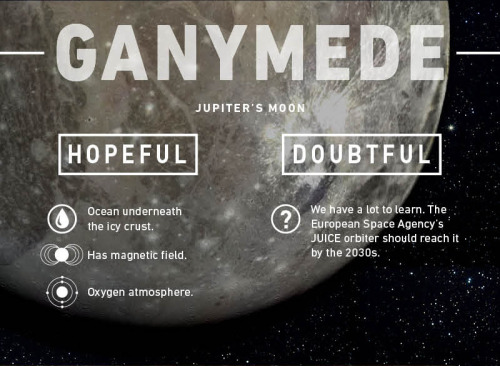



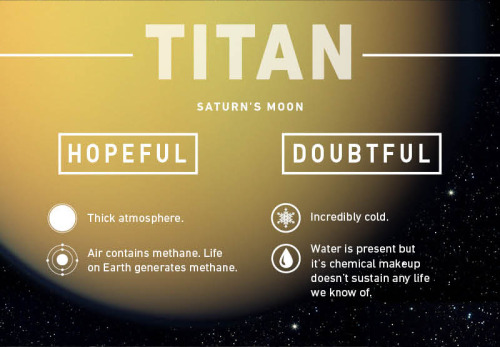
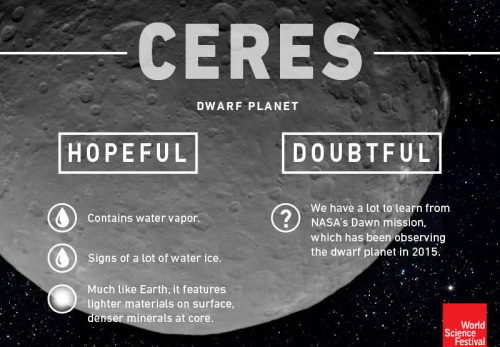
Where Could Life Exist?
When NASA scientists announced earlier this year that they had found evidence of liquid water on Mars, imaginations ran wild with the possibility that life could exist somewhere other than here on Earth.
Scientists continue to explore the possibility that Mars once looked a lot like Earth — salty oceans, fresh water lakes, and a water cycle to go with it. That’s exciting stuff.
So where else are they looking? What exactly are they looking for?
There are nine places in our universe where scientists say life is a possibility. The locations range from a smoking hot planet like Venus to a moon that orbits Saturn called Enceladus, which looks a lot like a massive, tightly-packed ball of ice.
All of these places show signs that water is, or at least was, a possibility. They also appear to feature some kind of energy that could produce heat.
full resolution
More Posts from Curiositytherover and Others



What would Earth’s skies look like with Saturn’s rings?
Illustrator and author Ron Miller specializes in, among other things, incredible visualizations of other worlds. Now, Miller brings his visualizations back to Earth for a series exploring what our skies would look like with Saturn’s majestic rings. Miller strived to make the images scientifically accurate, adding nice touches like orange-pink shadows resulting from sunlight passing through the Earth’s atmosphere. He also shows the rings from a variety of latitudes and landscapes, from the U.S. Capitol building to Mayan ruins in Guatemala.
Images and text via
Where did the stars go?
One day, you find time to get out of the clutches of your work life and you decide to gaze at the stars.
Something which you used to do when you were a kid.
But the city life with all its glory has diverted you to other ‘fun’ things.

But to your amazement you find that the density of stars has drastically decreased.
‘That’s preposterous’- you say to yourself. That can’t be true.
You are positive that it has something to do with you aging.

You decide to go to your eye doctor and do a thorough check up. The doctor concludes that your eye sight is perfect.

You are delighted, knowing that your eye sight is perfect and that you are going to see those stars again. You spend all day lamenting about it.
You crave for the starry night sky. And you are sure it would look like so :

So, the following night you go to the terrace to rejoice at the sight. But yet see that the sky is not starry at all as you had marveled.
In fact, there is a stark difference between what you had in mind and what you observe.

You get increasingly concerned about it. You ask a few people around and you find out that the answer to this mysterious phenomenon is Light Pollution..
And you start to explore this new bizarre form of pollution.
What is Light Pollution?
Alteration of natural light levels in the outdoor environment owing to artificial light sources.
What does it do?
The impact of light pollution is to reduce our eye’s limiting magnitude. That means that we can see fewer and fewer stars.

The differences in the number of stars that can be seen due to varying levels of background light pollution.
Light pollution competes with starlight in the night sky for urban residents, interferes with astronomical observatories, and, like any other form of pollution, disrupts ecosystems and has adverse health effects.
Light pollution is a side effect of industrial civilization. Its sources include building exterior and interior lighting, advertising, commercial properties, offices, factories, streetlights, and illuminated sporting venues.
How can I prevent it?
(Light Pollution and How to Reduce It)
The solution does not involve curtailing nightlife, hampering the nighttime economy or compromising safety. It just requires directing lights where they’re needed and eliminating waste.
Here what you can do prevent light pollution.
1) Only turn on outdoor lights when needed—or install motion sensors.

2) Point the lights downward and outfit them with “shields” to prevent light from traveling sideways. The goal is to shine them only where illumination is wanted—not in people’s eyes or on other people’s property (a case of “light trespass”).

3) Lower the wattage of your bulbs and put them on dimmers. Bright lights and dark shadows don’t improve safety, but reduce it.

4) Close curtains at night to keep indoor light in. If you live in a multi-story building, use black-out curtains to prevent bird crashes.

And, of course, please use energy-efficient lights to cut global warming emissions even more than you’ll be doing already.
Inspiration :
Here’s what the night sky looks now, with light pollution.

And here’s how it will look like without it.

This post is to educate all the followers of the blog about Light Pollution, and raise awareness about it.
“Stars can’t shine without Darkness”
and hence i urge you to do your part to curbing Light Pollution.
Have a good day :)
PC: NASA, classroomclipart, Umut Siliman, eschooltoday,medscape
How Do You Stay Fit on a Mission to Mars?
This mini exercise device could be the key!
Onboard the International Space Station, astronauts need to work out to maintain their bone density and muscle mass, usually exercising 2 hours every single day. Throughout the week, they exercise on three different pieces of equipment–a bike, a treadmill and the Advanced Restive Exercise Device (ARED).

All these devices are needed to keep an astronaut healthy.
However, deep-space vehicles like our Orion Spacecraft aren’t as roomy as station, so everything — including exercise equipment — needs to be downsized. The Miniature Exercise Device (MED-2) is getting us one step closer to being able to keep astronauts’ bodies healthy on long journeys to the moon, Mars and beyond.

MED-2 is a compact, all-in-one exercise device that we developed and will be launching to the space station Tuesday, March 22. Onboard the station, we’ll see how MED-2 will perform in microgravity and how it will need to be further adapted for our Journey to Mars. However, it’s already pretty well equipped for deep space missions.
So what makes MED-2 so great for deep space travel and our Journey to Mars?
1. It is an all-in-one exercise device, meaning it can do both aerobic and resistive workouts. When we go to Mars, the less equipment we need, the better.

2. It’s incredibly light. The MED-2 weighs only 65 pounds, and every pound counts during space missions.

3. It has 5 - 350 pounds of resistance, despite weighing only 65 pounds. Astronauts don’t all lift the same amount, making the flexibility in MED-2’s “weights” essential.

4. It’s tiny. (Hence its name Miniature Exercise Device.) Not only is MED-2 incredibly light, but it also won’t take up a lot of space on any craft.

5. It powers itself. During an aerobic workout, the device charges, and then that power is used to run the resistive exercises. When traveling to space, it’s good when nothing goes to waste, and now astronauts’ workouts will help power the Journey to Mars.

MED-2 is only one of many devices and experiments flying on Orbital ATK’s Cygnus spacecraft. To find out more about the science on the space station, follow @ISS_Research and @Space_Station on Twitter.
Make sure to follow us on Tumblr for your regular dose of space: http://nasa.tumblr.com

Roller Coaster Physics.
The principle that underlies the working of a roller coaster is simple. As you ascent to the top, your potential energy builds up. ( i.e the higher you go, longer the distance that the force of gravity can act upon)
This built up Potential energy gets released as kinetic energy downhill. ( Kinetic energy is the energy of motion- linear and rotational).
Now what Roller Coaster Engineers do is abuse this principle to engineering perfection.

Answer Time from Space!
I’m on day 321 of my #YearInSpace, and today I surpassed 500 days in space total. Let’s chat! Sat., Feb. 13 at 1:45 p.m. ET.

You’ve gotta see it in action.

For The First Time Ever, DNA Was Sequenced In Microgravity

Before US astronaut Scott Kelly returned from his year-long mission aboard the International Space Station, he shared photos of his very last sunrise in space.
I think you need to see the full photos, in all their glory:












Source

Perseid Fireball at Sunset Crater

Scientists extend an atom’s lifetime with a mirror
Scientists from Chalmers University of Technology have been able to extend the lifetime of an artificial atom, allowing it to remain charged for up to ten times longer. They achieved this by placing the artificial atom in front of a short circuit, which acts as a mirror. The distance between the atom and the mirror affects how long the atom “lives,” which is the time from when an atom is charged to when it returns to its ground state.
Research team leader and Professor of Physics Per Delsing says, “We can vary the lifetime of the atom by changing the distance between the atom and the mirror. If we place the atom at a certain distance from the mirror the atom’s lifetime is extended by such a length that we are not even able to observe the atom.”
Know more at: http://futurism.com/links/scientists-extend-an-atoms-lifetime-with-a-mirror/
-
 cernunnos1990 reblogged this · 2 months ago
cernunnos1990 reblogged this · 2 months ago -
 cernunnos1990 liked this · 2 months ago
cernunnos1990 liked this · 2 months ago -
 moominhousestorage reblogged this · 7 months ago
moominhousestorage reblogged this · 7 months ago -
 leda-timeandspace liked this · 1 year ago
leda-timeandspace liked this · 1 year ago -
 open-window-my-soul reblogged this · 1 year ago
open-window-my-soul reblogged this · 1 year ago -
 resctranexel liked this · 1 year ago
resctranexel liked this · 1 year ago -
 theonewhoseeksliberation liked this · 1 year ago
theonewhoseeksliberation liked this · 1 year ago -
 extraordinarybrai liked this · 1 year ago
extraordinarybrai liked this · 1 year ago -
 yuriggv reblogged this · 1 year ago
yuriggv reblogged this · 1 year ago -
 twotrees338 reblogged this · 2 years ago
twotrees338 reblogged this · 2 years ago -
 insecurities-broker liked this · 2 years ago
insecurities-broker liked this · 2 years ago -
 warcrimesimulator liked this · 2 years ago
warcrimesimulator liked this · 2 years ago -
 samodivas reblogged this · 2 years ago
samodivas reblogged this · 2 years ago -
 iwillhaveamoonbase liked this · 2 years ago
iwillhaveamoonbase liked this · 2 years ago -
 prometheanastronaut reblogged this · 2 years ago
prometheanastronaut reblogged this · 2 years ago -
 yogurt-culture reblogged this · 2 years ago
yogurt-culture reblogged this · 2 years ago -
 justremainingmyself liked this · 2 years ago
justremainingmyself liked this · 2 years ago -
 minho-enthusiasm liked this · 2 years ago
minho-enthusiasm liked this · 2 years ago -
 stornbreaker reblogged this · 2 years ago
stornbreaker reblogged this · 2 years ago -
 crookedcatstarlight liked this · 2 years ago
crookedcatstarlight liked this · 2 years ago -
 malikheruelshabbazz reblogged this · 2 years ago
malikheruelshabbazz reblogged this · 2 years ago -
 cleo7 liked this · 3 years ago
cleo7 liked this · 3 years ago -
 tinnedf1sh reblogged this · 3 years ago
tinnedf1sh reblogged this · 3 years ago